Historic-low layoffs, astronomical job openings, aggressive hiring, massive churn & job hopping: Weirdest labor market ever.
By Wolf Richter for WOLF STREET.
Reports of large-scale labor shortages in education, healthcare, transportation (airlines, good lordy!), and other segments rub elbows with reports of relatively small-scale layoffs in the most speculative segments of the economy – in the massively money-losing startup, SPAC, and IPO space. And there have been layoffs among mortgage lenders whose revenues plunged when demand for refi mortgages vanished and demand for purchase mortgages sagged due to spiking mortgage rates.
In July, the number of layoffs and discharges dipped for the second month in a row by a smidgen and remained in the record-low range in the data going back to the year 2000. The 1.398 million layoffs in July were down by 42,000 from July last year and down by 428,000, or by 23.5% from July 2019, according to the Job Openings and Labor Turnover Survey (JOLTS) released today by the Bureau of Labor Statistics, obtained from a survey of 21,000 employers.
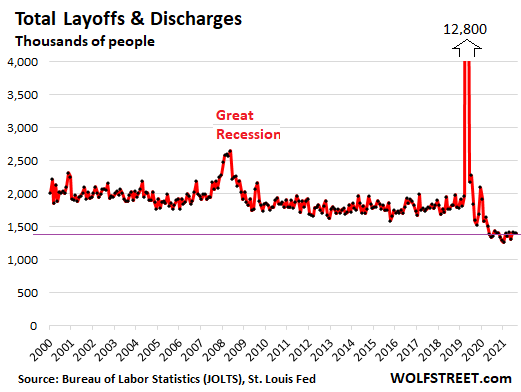
This low number of layoffs confirms the trends in the weekly unemployment claims data, released last week by the Department of Labor. The 243,000 initial unemployment claims that were filed in that reporting week were up just a little from the historic lows earlier this year.
In other words, relatively few people got laid off, and most of them found new jobs quickly, or already had a new job lined up when they got laid off from the old job and never bothered to file for unemployment.
In the past, recessionary periods were preceded by unemployment claims rising past the 350,000 mark. Initial unemployment claims from the Labor Department last week:
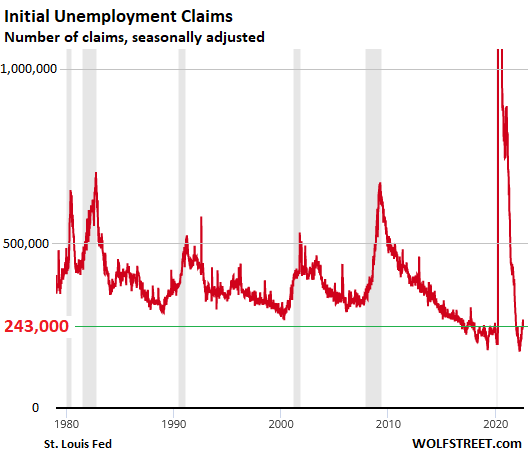
Job openings increase further: the astronomical zone.
Job openings in July, not seasonally adjusted, jumped to the second highest ever, to 12.09 million openings, just behind the record in April, up by 482,000 openings year-over-year and up by 4.45 million openings, or by 61%, from July 2019.
Job openings seasonally adjusted jumped by 199,000 from June, to 11.24 million openings in July, up by 456,000 year-over-year and up by 4.1 million from July 2019.
This is not based on some online job postings or whatever, but on the JOLTS data that the Census Bureau collected from 21,000 employers (businesses and government entities) by asking about their workforce in July.
This is another sign that the labor market remains tight and that many employers are having difficulties filling positions:
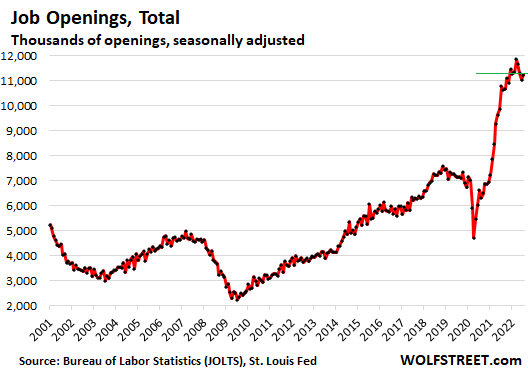
“Quits” back off a tad, still very high.
The number of workers who voluntarily quit jobs in July declined for the fourth month in a row, to 4.18 million, but was still up by 15% from the already high levels in July 2019.
“Quits” is a sign that employees either already have what they think is a better job lined up, or that they’re confident that they can quickly get one. This large number of “quits” reflects job hopping by workers who are trying to arbitrage the tight labor market for their benefit, amid still aggressive hiring by companies. This creates large-scale churn in the labor force.
But the four months in a row of declines indicate that confidence in finding a better job, amid stories about layoffs and hiring freezes and what not, is maybe deflating just a tad:
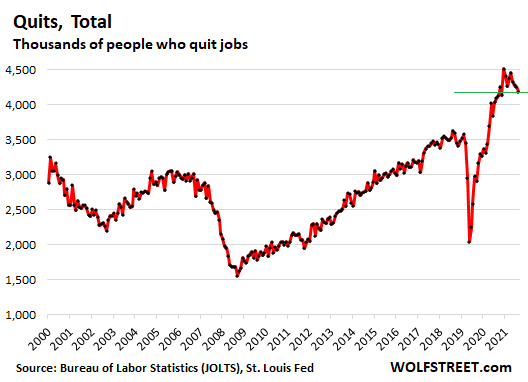
Hiring still very strong.
Private sector employers hired 7.1 million workers in July, not seasonally adjusted, which includes the remaining burst of seasonal hiring that had started in May and June.
Seasonally adjusted, employers hired 5.98 million workers, a dip from the prior month, and down 2.7% from the hiring boom in July last year. Compared to July 2019, employers hired 370,000 more workers (+8.4%).
These are not all new jobs that have been filled, far from it. Many of these “hires” filled jobs that were left behind when workers quit to work somewhere else as part of the massive churn in the labor force:
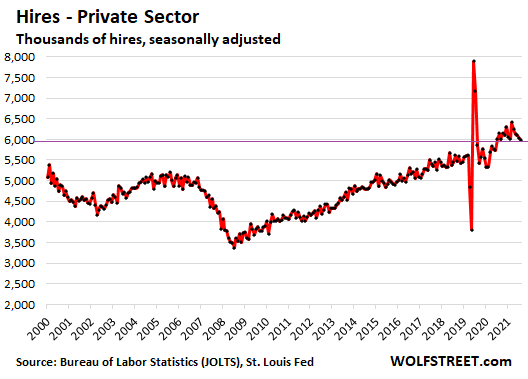
Job openings in the largest industry categories.
Professional and business services: The number of job openings in July dipped from June to 2.09 million, but were still up by 8.0% from July last year, and in a sign of just how crazy this job market is, were up by 63.1% from the already high levels in July 2019:
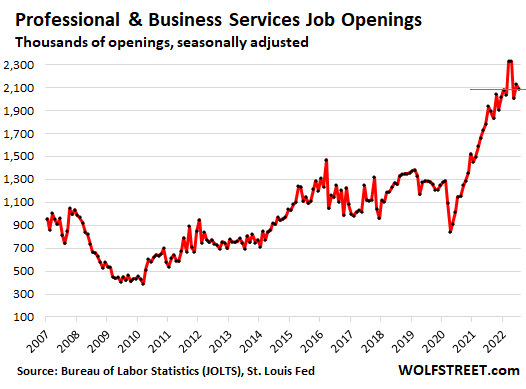
Healthcare and social assistance: Job openings dipped to 1.98 million in July, in the same astronomical 2-million range since December last year. Year-over-year, openings were up by 15% and compared to July 2019, they were up by 65%, amid endless reports of shortages of doctors, nurses, and other staff at healthcare facilities.
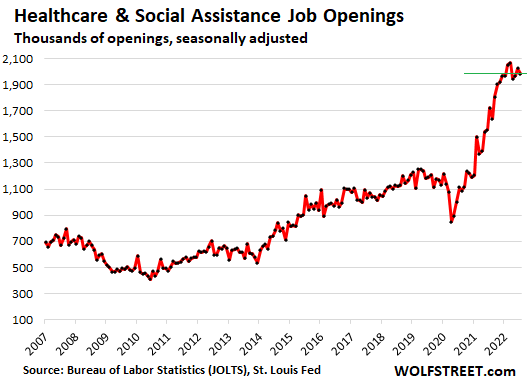
Leisure and hospitality: Job openings ticked up a tad from June, to 1.52 million in July, up by 57% from July 2019. Restaurants and hotels have made a lot of progress in staffing up, after the spike in job openings that occurred when restaurants and hotels reopened. Year-over-year – so from what was still the re-opening spike last year – job openings dipped by 5.3%:
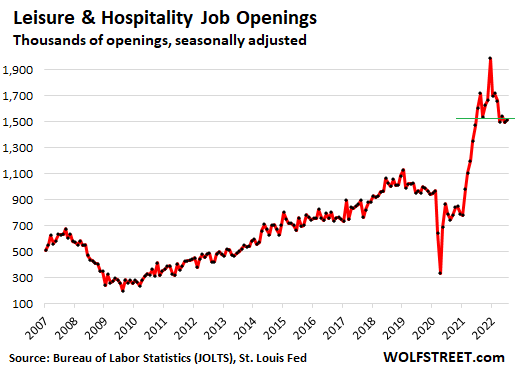
Retail trade: Job openings jumped in July to 970,000, but retailers have made progress in filling their spike in job openings that had occurred as the industry re-opened. Up by 16% from July 2019, retail job openings are reverting to normal-ish levels:
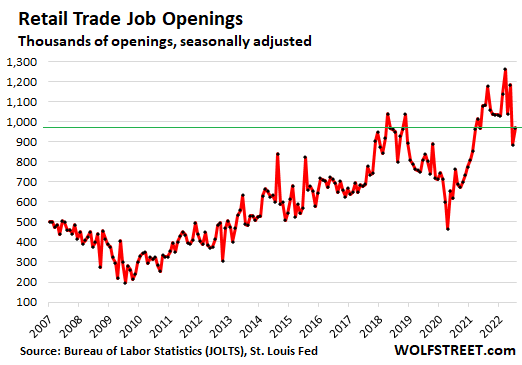
State & local government, mostly in education: Job openings jumped to 924,000 (seasonally adjusted), just a tad below the record in December 2021, and about the same as January, February, and April. Up by 52% from July 2019, amid endless reports of teacher shortages.
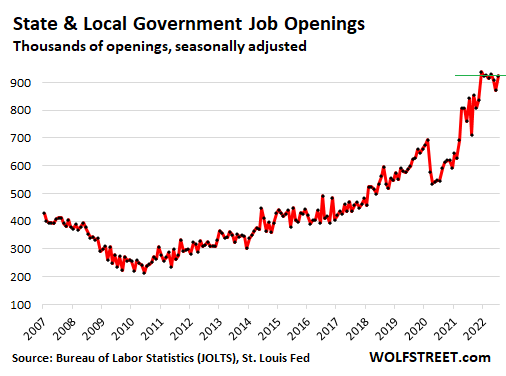
Manufacturing: Job openings, at 834,000 in July, remain in the astronomical zone, up by 92% from July 2019, but down some from the spike in April:
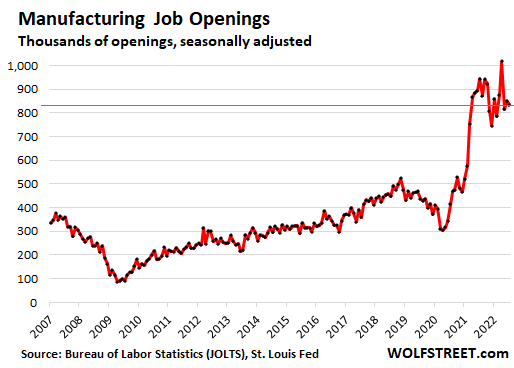
Construction: Job openings rose to 375,000 in July, up 11% year-over-year and up by 17% from July 2019:
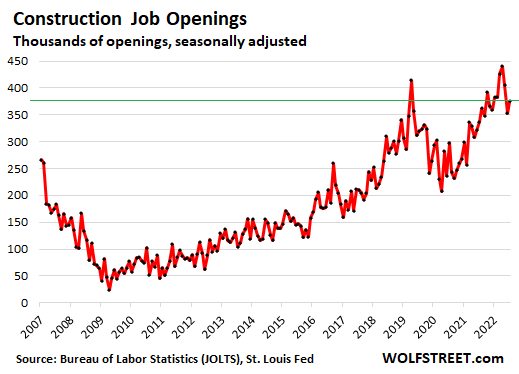
Enjoy reading WOLF STREET and want to support it? You can donate. I appreciate it immensely. Click on the mug to find out how:
![]()


I’m sure the origins and driving forces behind this bizarro world labor market are beyond complex, but the end result is the strangest economic situation the country has faced in nearly 100 years. Pretty curious how this will all turn out in the 2 to 5 year range.
Things can change very quickly.
What I dont see is the labor participation rate. I think that is still down from where it was pre-pandemic, which was already quite high.
So basically, when you give free money to people and jack up their home prices, they choose not to work. Remarkable???
Over the coming six months, if we can get a pause in the government hand-outs, maybe we will see people return to the workforce.
Do we really need more people in the workforce?
Not necessarily more people, but more people where the demand vastly outstrips supply. A lot of “employment” is non-productive (of either good or services) waste of lives: much of government sector, bloated monopolies, cash-incinerating profitless unicorns… it’s a long list.
not to worry
there are some 11,000,000 workers aged 60-65 that will RETIRE SOON
therefore we’re not going to see HUGE unemployment #’s
besides lots of woke mils/GenZ are gig workers
Good and service jobs are not a waste of lives.
The 25-54 rate peaked at 83.1 pre pandemic. It was 82.4 in July.
Just to clarify, that is the employed-to-population ratio 25-54 you are talking about right?
(Participation rate is a different metric, and one I’ve only seen for the whole population, and therefore much lower).
(The 25-54 numbers seem in the ballpark, but I wanted to confirm).
If so, I think that is one of the most telling metrics of the last 20 years (and one I think the Fed scrutinizes too, based on its multi decade actions).
The 25-54 ratio has never hit its late 90’s highs ever again – pretty much corresponding to the ZIRP era and a lot of bad outcomes for the US economy.
(And just to remind everybody, “employed” is subject to BLS definitions and says absolutely nothing about pay level).
Expanded unemployment benefits and stimulus impacts on the labor market have long dissipated by now.
There haven’t been any handouts since last year. The $1,400 payment was a one-time payment from the spring of 2021, the PPP loan program expired, and so did the unemployment booster payments and earned income tax credit increase. If you’re referring to student loan forgiveness, yes, that will affect a lot of people, but they still have to apply for that.
@Poor like you
Complex? Not really. Look at excess deaths (up 40%) and long-term disability claims (catastrophic) in 2021. Significant chunk of the labor force disappeared…in less than one year.
Get used to low unemployment #’s. The new normal. Likewise get used to persistent, entrenched, structural service cost inflation. Labor has the upper hand. Retirees might find themselves in high demand as contract labor.
Until workers own and control the means of production, expect continuous turmoil in the labor market.
But according to the article, it should be a job seekers market?
I remember a year before the pandemonium that graduates at my school were offering to work for free.
Now the newer generations refuse to work for minimum wage if it entails a hint of skilled labor.
Minimum wage hasn’t changed since 2009.
That may just happen with Bernie 2024! The C Suite pay is unsustainable and rank and file workers (which now also includes all the way through the upper middle class workers–80% of Americans) will not put up with it much longer. It is amazing what 80% of the population can demand and extract, if they unify around an issue such as worker’s rights and equity.
Workers that own the means of production were called Kulaks and murdered historically.
“ Until workers own and control the means of production, expect continuous turmoil in the labor market.”
If that happened, then they wouldn’t be
“workers” by definition, eh?
Correct, then under that arrangement, private corporations would not survive very long.
“ Until workers own and control the means of production, expect continuous turmoil in the labor market.”
Oh my, sounds like “workers of the world unite”… That didn’t work out too well.
There are numerous companies which you can easily find on a web search that are owned by their employees and are surviving nicely.
Credit-you wouldn’t ask or expect them to soldier for you, then?
may we all find a better day.
No need to give workers control of business…if we do then for sure business goes down ….look at Government motors…Textile industry in Ahmedabad , India ..once thriving industry and more then 100 big factories now no textile mill in that city…Unions killed it!
According to the WEF, they would be Stakeholder Capitalists. (err, Communists… but Communists that look like Capitalists).
That worked so well in the Soviet Union. A saying at the time:
“They pretend to pay us. We pretend to work.”
Be careful what you wish for.
That literally describes what is currently occurring.
That sound bite is getting kinda old Volvo. I personally “wish” you would substitute a good old fashioned “hard earned money” sound bite. Maybe something with one of those fearless “animal spirits” stock jockeys in it? You know, the “man up” and grab the bull by the horns stuff.
Or you can grab the little girl out there, if you aren’t an exceptionally tough worker.
Having owned a business I can tell you that if workers owned the means of production, they would run it into the ground. That is what unionization proves.
The workers who are qualified to run a business start a business and then hire others.
There is nothing wrong with capitalism, but there is something wrong with our society, where people expect something for nothing and educational status is used as a filter to keep the unwashed from achieving a decent wage. There is also something wrong with our tax system that taxes wages at a much higher rate than capital gains.
NAH tv, its the corruption in every system that is the foundation of every human problem caused by that system.
I realize its anecdotal, but the very best electrical subcontractor who bid and did work for our general contracting company was totally union.
Everyone working at that company was union, including the administrative staff, the project and field managers and all the journey and apprentice level field workers. Ownership was distributed to all long term employees/workers in list.
They consistently out bid and even more consistently out worked every other such company I worked with over fifty year span.
Talking electrical budgets/$$ in single digits MMs.
VVN,
How do you view government unions (including teachers’)?
They tend to be much, much larger than local private sector unions, much more politically aggressive, and (at least historically) were the beneficiary of a lot of MSM-promoted myths.
When I worked in unions ,if you didn’t work they sent you to the union hall .To set on the bench until another contractor needed help .If this was a recurring event ,then no contractor would hire you = out of job
Worker owned business works for co op, John Lewis and dozens of other worker owned companies. The successful ones do hire professional management rather than run it themselves though. Just like how rich shareholders or pension funds might not know how to run a company.
The factory I used to work at was uionized. The union workers seemed to be only ones who knew how to do stuff. The MBA’s sat in their air conditioned offices, never set foot on the factory floor, and complained constantly that the workers were only doing the minimum, lazy, etc etc.
Because of the constant criticism and blame game, the union response was; “we are only doing what you told us to.”
Unfortunatly, the MBAs and management didn’t know didley about either the factory work, or the product —- but they sure knew how to play financial games.
It would be interesting to see statistics of retirement numbers over the past few years to see if those could be a contributing factor to some of the observed worker shortages. Age demographics are bullish for retirements through the next 5+ years or so over 21 million people in the 55-59 age group. Fed might have a harder time cooling the job market than they anticipate with job openings still into the stratosphere. More support for aggressive rate hikes!
Retirements are a HUGE part of this labor market shortage. Many comments have pointed out differences between participation rate and “prime age” participation rate.
Similarly, the article could benefit by dividing these numbers by the civilian labor force level, LNU01000060
Fromks,
You’re mixing apples and oranges. You’re citing HOUSEHOLD survey data from the BLS, including LNU01000060.
This is data from EMPLOYERS!!! Nothing to do with civilian labor force!
Retirement is a function of the person’s ability or perception to be supported without working. They can either support themselves or someone else supports them, always. It’s not because of age demographics.
Using age as reason is a rationalization. In today’s environment, many people believe they can retire or have retired because of inflated asset markets which concurrently makes them believe they are more affluent. They are, in a sense, but this doesn’t apply to the economy in the aggregate because inflating asset values doesn’t increase production or productive capacity which is what makes mass (early) retirement possible.
“Reports of large-scale labor shortages in education…”
This an apples and orange comparison, but the local McDonalds is advertising jobs that start at $17.50 an hour. That probably requires at least a HS diploma, but I don’t know for sure. Starting teachers in the local school district make the equivalent of $20 an hour. And that does require a college degree.
Not much spread there.
“This an apples and orange comparison, but the local McDonalds is advertising jobs that start at $17.50 an hour. That probably requires at least a HS diploma, but I don’t know for sure.”
No HS diploma required to work in my friend’s 6 Burger Kings. All he wants is them to be able to count U.S. money and speak Spanish and at least some English. Oh, I forgot, and show up on time.
Up until recently, there was another job that paid around $20 an hour, the delivery driver gig job (Doordash, Grubhub, Shipt etc). I discovered this job in May and couldn’t believe how easy it was to collect money driving around the city. It takes one hour to get a background done at Doordash or Ubereats, so almost anyone can start doing deliveries one hour after they decide to do so. No commitment, no job interview, no experience, no problem. These delivery driver apps are just like computer games, except you get paid. I was making $1000-1200 a week. Now I’m down to $500-700 (the slowdown began two weeks ago), which is still way too much, considering that I only do the deliveries that pay over $20 an hour. Too many people are still paying ridiculous amounts for short deliveries. I expect my income to drop further to around $100 and eventually to zero if unemployment goes up and the market becomes saturated with desperate drivers who do the equivalent of getting an auto title loan. What most drivers don’t realize is that there is more than just gas expense. You can depreciate your car more than you earn doing deliveries. This job easily becomes a way to trade the equity in your car for quick cash, similar to a title loan.
You not making $20. You need to deduct your expenses.
See what I mean? You don’t believe it, either. I didn’t believe it until May of this year when I tried it. A lot of the runs pay a $1 a minute gross. It’s not believable. That’s how hot the job market is. But you’re also completely missing the point, which is this:
We’re not just bystanders trying to predict Jerome’s next move. We can take action to do our own QT. People are out there spending money willy-nilly. They’re giving out $20 tips on Ubereats deliveries. We need more rich people to go out and start doordashing. The money earned as a delivery driver is tax free when you open a solo 401k account. By putting the money away in a retirement account, we are effectively taking it out of circulation. It’s like doing our own QT. So if you want to get inflation down, sign up with Grubhub, Shipt, and Spark now, whoever pays the best in your area. Take those ridiculously high tips and don’t spend it. This will bring inflation down.
My 16 year old daughter is making $16/hour ($20+/hour with tips) in semi-fast food for a summer job.
I used to think that I had it lucky making $4/hour for a 3 month summer job ($1920) when a state university tuition was $1200/year.
At $20/hour = $9600.
Oops, it still doesn’t cover the $12K/year state college tuition.
I guess despite the current $20/hour, I was still a very lucky student back then making $4/hour.
I was at the barbershop today and a woman came in to buy peaches. She said that McDonalds in L.A. was paying $22.50 / hr. I asked her what they were paying locally (suburban Chicago) and she said $15.50
Exactly why was this woman shopping for peaches in a barbershop?
A customer brought in a bushel of peaches . They have paper bags available and you help yourself and leave a donation in a cup.
MiTurn,
You’re not take into account that teaching public school is a 9 month a year job. Using the US median first year public school teacher salary (41,770 according to the NEA) it works out to about $29 per hour assuming 40 hour work weeks.
There is also the benefits, which tend to be pretty good, and a pension if they can stay in the job.
They are also exempt from Social Security taxes, which makes $44,770 the equivalent of 44,485 for a private sector employee.
I by no means mean to imply that teachers are overpaid, but you do have to take into account the totality of the compensation package.
take –>taking
Teachers are not exempt from Social Security taxes in every state.
Teachers pay for those benefits. After health insurance and pension deductions there isn’t much left of that 42k.
I have always wanted to be a teacher. However, in the world of IT – I make near triple what our local teachers make. I do not make enough, without my husbands income, to live in this school district. I could not imagine a teacher being able to live in their school district and that is a shame. Quality over quantity is an expensive lesson to learn with a child’s education. No wonder kids never get taught the fine art of financial well-being.
Why take the NEA’s word for anything?
There are much better, much less intimately biased sources of data.
Hell, I trust the G’s data more than that of public union lobbiers.
McDonald’s workers don’t get 12 months of pay/benefits for 9 months of work, like teachers’ do, for one. McD pays for hours worked, not by union rule definition.
Next, $17.50 per hr (if accurate) for McD is a development of the past 12-18 months…historically it was far less.
Also, what is the percentage of non-teaching “teachers” (administra-klura) in your “teachers” union/school district?
There is a reason why school districts are frequently multi-billion dollar operations (despite their geographic narrowness) and it ain’t because of the legendary $40k teacher (whose pay raises how far, how fast?).
I’m a public school teacher in Richmond CA. I make about $45 an hour. I’m not an administrator or very far along the step system. They make significantly more, and you have summers off.
JT,
Thank you for your honesty and integrity.
The teachers’ unions are huge political game players and vastly misrepresent the financial situation of most teachers/administrators, school districts (which are huge, costly operations – frequently among the top 5 business entities in *many* locations), and the taxpaying public.
Complicit/corrupt/brain dead MSM outlets have spent decades promoting the myths that the public sector unions cultivate.
My son was hired at McDonald’s for $14.00 per hour. Per my son, no one is showing up to work, which is causing a very difficult work environment so He Quit. He said he would rather find an “easier” job, like a bookstore.
Job openings is absolutely the number to keep an eye on, even more importantly than unemployment claims. A big fast dip in job openings will tell us that the economy is on its way down the tubes. Employers will also slow or freeze hiring before they jump straight to layoffs. Many employers may find that what is considered “understaffed” today will be comfortably staffed in a slower economy, which means few layoffs, but no hiring. So job openings fall off well before unemployment claims blow up in this bizarre economy.
No major loosening by the Fed until those job openings come down either. Maybe a pause in rate hikes with continued QT in 2023. If tighter monetary policy strangles jobs and we see openings fall off aggressively along with softening inflation, THEN watch for the Fed to ease up on the brakes, but not until then. Tightening deniers will not get a chance to gloat as long as 11M+ jobs are sitting unfilled. Neither will would-be asset buyers waiting for a major crash in prices.
They’re definitely not going to pause the rate hikes this year. No way in hell.
Not this year. I said, “in 2023” because multiple fed Governors have hinted at an upcoming pause in rate hikes, and it’s in the meeting minutes as well. QT is going to be dependent on more generalized economic conditions. The labor market can turn pretty quickly, but it would be astonishing for it to turn bad enough fast enough this year to cause a Fed pivot.
Poor,
I am not betting on that. Financial markets are so leveraged and complex and a lot of assets used as collateral that the tightening cycle probably will not go as Powell tells us it will. It’s probably going to be “gradual then suddenly as something big breaks.
11.2 million job openings as of this morning. They are actually increasing.
Perhaps not a “major” crash in equities, depending on how you define the word “major,” but we do seem to be on the cusp of another significant downdraft, following what appears to have been a classic bear trap.
Equities go up and they go down. Banksters probably wouldn’t mind a continued stock market crash… The little guys get hosed, and the larger institutions backed by a friendly government step in and buy up the bargains.
I was talking about assets. Prices of houses, farm land, etc. are not going to collapse GFC-style while institutions remain flush with cash, and while anybody who wants a job can get one or jump jobs for better pay. Interests rates will continue to put pressure on house prices, but anybody dreaming about a 30%-50% discount like in the last crash is going to have to keep dreaming as long as the labor market remains strong. House values didn’t go up, the value of the dollar went down.
Not sure
Labor shortage won’t go away any time, soon. With 22 Millions (work force) above 55y (majority 65y-75y) slipping slowly into retirement in the next 5-10 yrs, there will be more openings than job seekers! Making fighting inflation more difficult, for Fed.
No matter what, this 3rd largest ‘everything’ bubble of the 21st century is slowly leaking. Risk outweighs the benefit of staying in the mkt, for the next decade.
Exactly what I’m thinking Sunny!
“ Until workers own and control the means of production, expect continuous turmoil in the labor market.”
Oh my, sounds like “workers of the world unite”… That didn’t work out too well.
@ Not Sure – look more carefully at the charts, from 2005-2009.
Remember that recession started in late 2007.
Watch Quits – that’s the best leading indicator.
Hires is next.
Job Openings is at best a coincident indicator.
I live in a suburb of Chicago and there are help wanted signs everywhere from service workers, warehouse, auto mechanics, laborers etc. Linkedin is full of engineering jobs for Chicago and surrounding areas. Have never seen so many. If we’re headed for a recession it will be the strangest I’ve lived through.
We’re not headed for a recession anytime soon. The constant media harping about one was just another of their taper tantrums because Powell was taking their free sugar away and they were trying to scare him into a pivot.
This labor market info shows how overheated the economy is, how entrenched inflation has become, and how difficult it will be to dial it back. It’s going to take A LOT more rate hikes and QT to slow this locomotive down. The money printers, politicians and bureaucrats didn’t do the math on their stimulus, and now it’s tearing shit up.
Seeing much the same here in Wisconsin. Everywhere there are signs for help wanted in service biz, restaurants, retail, warehouse, mechanics.
We can’t keep employees where I work. They show up, realize the work is hard, then bail.
In what industry would that be?
That might be a management problem with an inability (or indifference) to inspire and motivate new hires. Satisfied, fairly compensated Employees are the engine that drives all successful ventures. Take away the workers you have nothing–and this article is a warning employees will go to work for themselves or as independent contractors (where available) before they suffer poor employers.
“Enthusiasm is one of the most powerful engines of success. When you do a thing, do it with all your might. Put your whole soul into it. Stamp it with your own personality. Be active, be energetic, be enthusiastic and faithful, and you will accomplish your object. Nothing great was ever achieved without enthusiasm.”
— Ralph Waldo Emerson
I have found that the sure way to drive off employees is a bunch of checkbox requirements are required trainig for day to day work, which has gone up exponentially. When I got my first programming job at a real company with 2000 employees in 1985, the hiring manager called me in, we had a person-to-person interview, no background check, no HR, and I was hired on the spot. There was not one hour of “training” the whole time I worked there. Compare that to today.
Meant to say “checkbox requirements *and* required training”.
Long hiring processes are probably a factor in vacant positions staying open. I’ve heard from friends who work in Big Tech that they had to go through as many as 8 rounds of interviews before getting the job offer. From the employee point of view, jumping through those hoops is worth it given how much the tech jobs pay. But from the company point of view? I can see the logic for 2 rounds if you get a ton of applicants (initial screening and full interview), but if the company can’t decide which candidate to hire after 2 rounds they’re too indecisive.
I’m not sure the salaries matter as much as you think. I worked somewhere that starting salaries were well above average, but many applicaints checked out and never came back when we told them company policy did not allow cellphones into the work place. You could clearly tell in the interview that at that point they were no longer interested.
Companies use the interviews as hoops for the applicant to jump thru. This allows the companies to weeds out the non compliant employees.
The pay is not commensurate with the work.
The inflation, the mysterious labour shortage, the monopolies and the changing of the workplace culture all tell the same story;
Ineffiency.
The 65-and-older population grew by over a third (34.2% or 13,787,044) during the past decade (2012-2022)…
Total workforce grew from 201M in Jan2012 to 207M in Jan2022. That’s a deficit of 7M people…
Now not everyone who turned 65 retired, but I bet a lot did. And after the pandemic, many women never returned to the workforce… so let’s call that a wash.
So, “Job openings in July, not seasonally adjusted, jumped to the second highest ever, to 12.09 million openings… up by 4.45 million openings, or by 61%, from July 2019.”
Now if we look at the Job Openings – Total chart, it shows about 4M openings in 2012, which has grown fairly steadily (ignoring a pesky pandemic) by about 8M in the past decade.
So, are we seeing the long term greying of the American workforce and it’s impact on long-term employment?
WolfGoat, I see a lot of formerly retired people working fast food. I talked with one guy and he said he went back to work at the local McD (a former lumber mill worker) because he was a bit bored, he only worked part time, and the pay was good enough to entice him to do it.
Many in government jobs retire between the ages of 55-62.
Great op ed in the WSJ today that explains a possible cause to the labor shortage. Obviously written with a bias, but the stats are probably accurate. The gist of it is that with all the transfer payments (which aren’t included in income) that the lowest two quintiles get, their income level is approximately flat with the middle quintile. So why work? Perhaps not a great social decision but a perfectly rational economic one.
One more perspective on employment and perhaps Social Security…
In 2020, about 16.9 percent of the American population was 65 years old or over; a figure which is expected to reach 22 percent by 2050. This is a significant increase from 1950, when only eight percent of the population was 65 or over.
In recent years, the aging population of the United States has come into focus as a cause for concern, as the nature of work and retirement is expected to change in order to keep up.
If a population is expected to live longer than the generations before, the economy will have to change as well in order to fulfill the needs of the citizens.
In addition, the birth rate in the U.S. has been falling over the last 20 years, meaning that there are not as many young people to replace the individuals leaving the workforce.
This isn’t odd to me. I just spent a month traveling around the PNW and there are help wanted signs everywhere for all kinds of work. The boomers – which is a worldwide group – has always been the pig in the python and are nearing the tail end. The Rona pushed many of them to retire and gen z, the everyone gets a trophy generation, is not compelled by their families or society to get careers. Add in a well fed massive welfare class and you’re left with a pretty thin working class that can’t meet demand for goods and services. It’s structural.
And with our political gritters class coming up with new bills to increase inflation weekly (and commodities and services reflecting this, which permeates all levels of the economy) , I could see the fed raising rates for a very long time because it’s not accounting for these structural changes that are working against it’s goals. We could very well be at a 5% fed funds rate 1.5 years from now but still in the same predicament given the political and demographic landscape.
Over the last two weeks the company that I work at laid off 50 workers (from the factory floor). We can’t get the components that are needed for our widgets. Supply Chain issues.
Yes, that has been cited in lots of places.
How many people are on welfare, they should become productive humans .work 52 years like I did what happened to Clinton program .I believe 2 years of benifits then get a job .Will clear up labor problems quite quickly
What is the percentage of the workforce employed? According to the OECD the workforce would be those 15 to 64. In the US a large portion of that age group is in the military or prisons. Subtract those from the workforce of 15 to 64 year olds. Then subtract the remainder from the total population. One of the problems with employment statistics is that they don’t count those not looking for a job. There are able bodied people who simply are not looking for work. They happen to be unemployed. Unemployment statistics are about reliable as inflation statistics.
The 25-54 rate is a bit below pre pandemic level (83.1 vs 82.4 in July). That is 0.7% off.. probably 1-2 million people.
In July the JOLTs had 11 million openings.
This whole “people just aren’t working” narrative isn’t going to solve this.
Data is a head scratcher. Sounds like we need a few papers to get a better handle on what’s going on with labor. Weird means historical based theories/models are potentially unreliable.
Would also be useful if there were comparisons with what is going on in USA with other countries, to get insight on whether this is a global or national phenomenon and what factors are contributing. A lot of possibilities seem out there but not much rigorous analysis of data published.
Hard to make any conclusions other than it’s weird.
My wife has a theory on this. For calendar years prior to 2022, you would get a 1099-K issued by payment card networks if you had gross payments exceeding $20,000 *and* over 200 transactions. So as a gig worker, you could make several hundred thousand a year and have no reportable source of income, if you required customers to pay you via payment networks. This made gig work more attractive for tax cheating. As of 2022, the law has been changed for 1099-K reporting to gross payments above $600 and any number of transactions. Since the loophole has been closed, my wife expects to see a drop in gig work and a larger reportable labor force. I’m not convinced, but we’ll see.
There are no gig workers making several hundred thousand dollars a year.
But many make $30K or more, which is enough for this to potentially make a difference. Like I said, I am very skeptical about this, but my wife’s insights have surprised me more often than not.
And by the way, she said that for California, the Medical threshold is the key, which is $18,755 for a single person. I’m skeptical because people still get massive ACA subsidies past this threshold. She says other threshold based benefits may also disappear for these people, making gig work much less attractive.
Medi-Cal, California medicaid, not medical.
That’s an interesting theory, it will be interesting to see how that pans out!
From my point of view, it feels like mostly demographic change that was accelerated by the pandemic, with a tinge of societal decay plus the unwanted side effects of too much free money for too long.
My friends and I friends are all middle millennials and are now raising kids. We are all struggling with the idea of a two income household. With the cost of transportation and daycare, the juice just ain’t worth the squeeze. My wife, and several friend’s wives just dropped out of the workforce (mostly) to stay home with the kids. Several nurses, two teachers, and a dental hygienist just to name a few.
My wife works a few shifts PRN as a nurse and she doesn’t leave the house for under $45/hour. It’s just not worth it.
How does all this line up with the workforce participation numbers? Where are we at compared to where we should be when it comes to total number of people in the workforce? It seems that the main issue is not that there are so many jobs, but that there are so few workers.
Before the Dotcom bust we see the participation rate peak around 67.3% in April 2000. Then before the housing bust we see it back up to 66.4% in December
2006. Then 63.4% right before COVID shutdowns. Now we have a high of 62.4% back in March of this year and we May be entering a down trend now?
https://fred.stlouisfed.org/series/CIVPART
People get fooled only so many times. Care for me, who cares for you, is now rampant. Get used to it.
Workforce is leveling off, we have been bouncing between 205-207M workers since about 2016. I believe Wolf’s focus on ‘churn’ is a good indicator of the fact that folks can’t keep help for very long.
Enormously Confusing…these numbers are all six sigma disparities from the mean…not reliable (in my opinion anyway) — but we’ve all gone thru a world-wide epidemic, even the bean counters…PJS
Maybe this is more demographics driven. Baby Boomers were naturally retiring, then pandemic hit with its crazy rules of engagement, followed by the mandates and nonsense. Lots of soon to retire folks, just said “that’s it, I’m outta here” and retired. Poof, openings and no one there to fill.
Smaller generations following Boomers perhaps without quite as much initiative, and with fewer numbers just can’t fill the openings.
Wild guess theory but hey what else do we have?
But as of today, it is the younger people that haver a lower than historical participation rate (percentage) and the older people that have a *much* higher than historical participation rate. Something else is going on.
The economy isn’t the only thing that gets a vote. Demographics also plays a role and the participation rate is still very low, 62%. Thanks to current population trends, I think we are going to see a new normal with job openings more resistant to current economic trends.
BBC have a piece today that may say something about the demographics.
“US life expectancy falls to lowest level since 1996”
A falling life expectancy translates to a higher death rate. The speed at what rate the people leave the workforce is accelerating.
My LinkedIn feed is saturated with people who have been let go and are now unable to find a job. Tech. Wait until August comes out.
Layoffs.fyi is a good place to see real time metrics.
The weekly “initial unemployment claims” –people filing for unemployment insurance — through last week show that when people get laid off, and the numbers are still small, they find a job very quickly, or they already have a job. Second chart from the top.
If you’re into crypto or the metaverse, well then, you might want to replace those terms with different keywords.
In the last month # of layoffs:
Snapchat: 1280
Wayfair: 870
Peloton: 784
GoHealth: 800
Hootsuite: 400
Groupon: 500
Loggi: 500
Vroom: 337
Robinhood: 713
Ola: 1000
And initial claims are already averaging higher than pre-covid and up 50%ish from April/May lows. And from my own experience in tech – slack is entirely gone from labor market. No more negotiations, no more leaving to take other offers + lots more people who don’t have a job currently applying.
>1.75 total layoffs and discharges for August is a lock based on what I’ve seen.
I think no one’s denying that the Tech sector has been shedding jobs. The question is, are you seeing the same for other sectors?
give it another month. Wolf will be eating crickets for dinner- errr i mean crow.
Loopy G,
BS. I love crickets (fried).
I’ve been waiting for big layoffs for months. But they’re just not happening.
These layoffs THEWILLMAN listed are just little bitty stuff, and people get new jobs before they walk out of their old job.
These layoffs that THEWILLMAN listed are EXACTLY what I spelled out in the article in the first paragraph. Don’t you people ever read anything, not even the first paragraph? These are the companies that are in my Imploded Stocks column, layoffs and all. Don’t you people ever read anything on this site?
https://wolfstreet.com/category/all/imploded-stocks/
Are you people too young to remember the mass layoffs in 2008-2010?
Mass layoffs would be something like 40,000 at GM, 35,000 at Ford, 40,000 at Facebook, 50,000 at Google... that kind of stuff… day after day… where people cannot find a new job and they file for unemployment compensation. I’m waiting for it, but it’s just not happening yet.
I report to you what IS happening. And when we finally get mass layoffs, and the labor market changes in a real way, I will report that as it’s happening, but it’s just not happening yet, no matter how much you may wish for it.
The consumers are filled with cash. Absolutely no slowdown in spending.
Let’s wait and see.
Youngsters need to understand when they hear all this ‘work today paid today’ stuff or ‘gig economy’ crap the translation for all of these is… NO PENSION! It’s already likely that the azz end of the Millenial generation will have no social security. Combine that with a nation who has all but eliminated pensions & we’re taking about some major 3rd pain to be felt in the not so distant future. People shackled themselves to jobs for the pension. You have major cities in America that have discontinued pensions for firefighters. Can you believe risking your life with no pot of gold or leprechaun at the end of the rainbow. GenZ is gonna have to fight hard to regain all of the losses that occurred in the labor section in respect to pensions. It’s sad that they think all this gig economy musical chairs is some sort of ‘freedom’ for them. every generation has to fight its own fight
Looking at these statistics, one could get the impression most americans get a highly-paid, secure job with the gubment and then go out and spend the proceeds eating out and getting their hair done.
It’s paradise and Nirvana combined. Last time that happened was in the USSR. It was fun while it lasted.